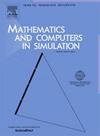q-HAGTM在糖尿病动力学中Hilfer分数阶微分方程分析中的新应用
IF 4.4
2区 数学
Q1 COMPUTER SCIENCE, INTERDISCIPLINARY APPLICATIONS
引用次数: 0
摘要
分数阶微积分已成为一个有价值的工具,建模复杂的动力系统,因为它能够表示记忆和遗传特征。在各种分数阶算子中,Hilfer分数阶导数因其在Caputo和Riemann-Liouville导数之间插值的独特能力而特别引人注目,为分数阶建模提供了一个通用的框架。尽管各种数值和解析方法已被用于求解Hilfer分数阶微分方程,但q-同伦分析广义变换方法仍未被探索。在本研究中,我们将葡萄糖-胰岛素相互作用模型扩展到Hilfer分数框架,并应用该方法分析其动力学。该方法提供了一种有效的解决技术,突出了其分析复杂分数阶生物系统的潜力。为了证明该方法的有效性,我们分析了所得解的唯一性和收敛性。数值模拟和图形表示说明了模型的行为,证实了该方法的有效性。本文提出了q-同伦分析广义变换方法在Hilfer分数阶方程中的一种新应用。结果证实了该方法在获得可靠解方面的适用性和有效性。这些发现有助于更广泛地理解分数阶建模,并展示了这种方法在未来数学建模研究中的潜力。本文章由计算机程序翻译,如有差异,请以英文原文为准。
Novel application of q-HAGTM to analyze Hilfer fractional differential equations in diabetic dynamics
Fractional calculus has emerged as a valuable tool for modeling complex dynamical systems due to its ability to represent the memory and hereditary characteristics. Among the various fractional operators, the Hilfer fractional derivative is particularly notable for its unique capability to interpolate between the Caputo and Riemann–Liouville derivatives, providing a versatile framework for fractional-order modeling. Although various numerical and analytical methods have been used to solve Hilfer fractional differential equations, the q-Homotopy analysis generalized transform method remains unexplored. In this study, we extend a glucose–insulin interaction model to a Hilfer fractional framework and apply this method to analyze its dynamics. The approach provides an effective solution technique, highlighting its potential for analyzing complex fractional-order biological systems. To establish the validity of our approach, we analyze the uniqueness and convergence of the obtained solutions. Numerical simulations and graphical representations illustrate the model’s behavior and confirm the method’s effectiveness. This study presents a novel application of the q-Homotopy analysis generalized transform method to Hilfer fractional equations. The results confirm the applicability and effectiveness of this method in obtaining reliable solutions. The findings contribute to the broader understanding of fractional-order modeling and demonstrate the potential of this approach for future research in mathematical modeling.
求助全文
通过发布文献求助,成功后即可免费获取论文全文。
去求助
来源期刊

Mathematics and Computers in Simulation
数学-计算机:跨学科应用
CiteScore
8.90
自引率
4.30%
发文量
335
审稿时长
54 days
期刊介绍:
The aim of the journal is to provide an international forum for the dissemination of up-to-date information in the fields of the mathematics and computers, in particular (but not exclusively) as they apply to the dynamics of systems, their simulation and scientific computation in general. Published material ranges from short, concise research papers to more general tutorial articles.
Mathematics and Computers in Simulation, published monthly, is the official organ of IMACS, the International Association for Mathematics and Computers in Simulation (Formerly AICA). This Association, founded in 1955 and legally incorporated in 1956 is a member of FIACC (the Five International Associations Coordinating Committee), together with IFIP, IFAV, IFORS and IMEKO.
Topics covered by the journal include mathematical tools in:
•The foundations of systems modelling
•Numerical analysis and the development of algorithms for simulation
They also include considerations about computer hardware for simulation and about special software and compilers.
The journal also publishes articles concerned with specific applications of modelling and simulation in science and engineering, with relevant applied mathematics, the general philosophy of systems simulation, and their impact on disciplinary and interdisciplinary research.
The journal includes a Book Review section -- and a "News on IMACS" section that contains a Calendar of future Conferences/Events and other information about the Association.
 求助内容:
求助内容: 应助结果提醒方式:
应助结果提醒方式:


